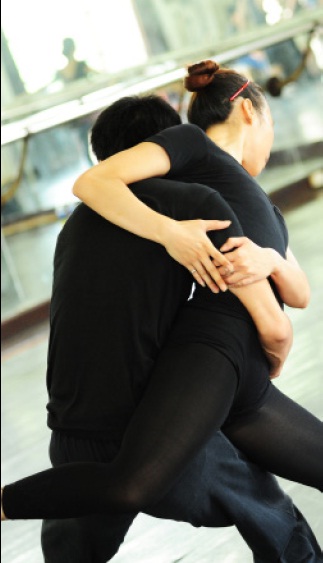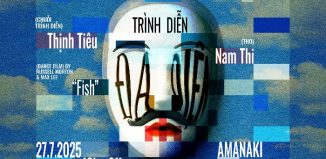Mai Chi – Death and the Maiden
 |  |
The last dance belongs to death
Eleven dancers stand side by side, bare footed, clad in contemporary clothing, men in long trousers and half-sleeved shirts, women in knee-length dresses, all in earthy colors of grey, brown, green, black and white, being silent for a moment. As the first bars of music start, they break into movements. Moving in slow motion across the stage, as if under water, linking hands, they form one human wave after the other, flowing forwards and being pulled back. The chamber music swells dramatically, relentlessly lashing the dancers through pain and despair.
For his contribution to the mini-festival “Europe meets Vietnam in Contemporary Dance 2011” in Hanoi, German choreographer Hans Henning Paar chooses a theme which is out of mind of most Vietnamese today. It is about Death.
In the old days, when the cyclic rhythm of the seasons, of sowing and harvest, of growth and decay was still in people’s bones, death was a natural part of life. But as rice fields are being turned into pavement and people are moving into offices, death has been downgraded to a footnote. The party has just begun; dazed by the frenzy of new urban life and bright promises of fresh money, who wants to think about the time they have to leave? As if to prove the point, the opening work of the three-piece dance night, a Vietnamese production, talks in its program notes about “love of life and romantic love overcoming difficulties and exhaustion to go further to a bright future”.
Paar had training in classical ballet and had already started to choreograph during his studies. For the past 5 years he has been the artistic director and chief choreographer of the dance company of the Theater am Gaertnerplatz in Munich, leading an ensemble of close to 20 dancers. He seems to love working based on literature and music; his works of last year and this year include choreography of Shakespeare’s Midsummer Night’s Dream, Franz Schubert’s Winter Journey and Kafka’s The Castle. Paar bases the Hanoi piece on the first two movements of Schubert’s string quartet Death and the Maiden. Written when Schubert was going through a difficult phase of illness, the dark and haunting composition is one of his most famous works and a pillar of Romantic music, a deep musical expression of Christian myths. The quartet is like the anticipation of the composer’s death; he died just three years after completing it, at a mere 31.
The theme Death and the Maiden is deeply rooted in the European culture and has carried its fascination to artists for centuries, but unlike its usual, traditional representation with the dialog and contrast between the dark figure of death and decay, and the female body as symbol of youth, beauty and hope, Paar’s narrative has a twist. He has introduced a third figure, the lover. In the center of the piece lies the interaction of the trio, starting with the quartet’s second movement, a theme and five variations, each expressing a different emotion. But what we see is not a violent struggling between antagonists, death and the lover, trying to possess the girl. They are more like brothers courting the same girl, an impression underpinned by the similar physical stature of the two dancers. Death is not threatening; he oscillates between being powerful and tender, mysterious and affectionately soft, beguiling and darkly comforting. The stage is kept bare except for the layers of paper shreds scatted on the floor, rustling with the dancer’s movements, adding a layer of sound. The music is full of sudden dramatic shifts from very intense to very soft, from the lyrical to the compelling and dramatic. In one beautiful moment, the trio stands motionlessly at center stage, the maiden and death facing each other, while the lover is a step aside, facing away, as if about to leave, but his hand still touching the maiden, not letting go. There they are, resting in frozen postures, surrounded by dancers swirling lightly around.
During the hot and humid month of August, with the financial support of the local Goethe Institut, Paar works with the young dancers of the Vietnam Opera and Ballet (VNOB); rehearsals take place in the facilities of the ensemble. The VNOB building itself is an apt symbol of the position of dance in Vietnam today. A non-descript 4-storey house tucked away in a little lane, grey, dusty, and uninspiring, it looks more like an office of a Tax Department rather than a place of creativity. Long gone are the glory days where dance and theater were embraced by the Party to serve its propaganda, yet being left aside by the post-reform entertainment market, dance is living a life on the margin of subsistence. The VNOB, one of the most prestigious addresses in the scene, is no exception. Between a commission from the Party to celebrate an anniversary here, a show for the opening of a new Toyota showroom there, there are few chances for dancers and choreographers to go about their profession. Collaborations with one of the foreign cultural institutes such as this project offer dancers the very rare opportunity to immerse themselves in professional work and develop their skills, the reward for month-long hard work being just one or two public performances. The last generation of Russian-trained ballet dancers is fading out; meanwhile, dance academies are facing difficulties recruiting students, especially male ones.
So the challenges for Paar in this project are not just in the language difference (all communication needs to go through translation), but more importantly in bridging the gaps between the two systems, two working styles. Dancers would come late or miss rehearsal entirely; phone calls answered in between dance moves, there is a lack of concentration and discipline, of active responsiveness. Given the situation, Paar’s achievement is even more remarkable. Starting out with a loose troupe of indifferent or even skeptical dancers, with patience and sensibility (this is his second collaboration with the VNOB), he slowly builds up their interest, gets them engaged, and wins them over. The rehearsal room may be dusty and desolate; the air-con half broken down, but when the dancers get in line and the music starts, there was a magic spreading in the air, filling the room.
While being torn between death and the lover, the girl slowly gravitates away from her lover, and at the end she gives herself to the hypnotic seduction of death, who embraces her softly. The lover fades out, leaving death at the empty center stage, gently carrying the sleeping girl in his arms. The music comes to a melancholy end. Death is something universal, he has the last dance.
After two performances in Hanoi, Paar will give the choreography to the VNOB as a gift. Chances are small that it will be ever performed again. But seeing the joy on the dancers’ faces and the pride they radiate as they bow to the audience at the end of the premier night offers something of a solace.
Europe meets Vietnam in Contemporary Dance: Death and the Maiden, Hanoi, 8 – 9 September 2011
Choreography: Hans Henning Paar
Dance: Vietnam Opera and Ballet
Music: Franz Schubert
Costume: Hans Henning Paar
![]()
| Mai Chi is a Hanoi-based arts commentator and has been contributing to various online media. |













